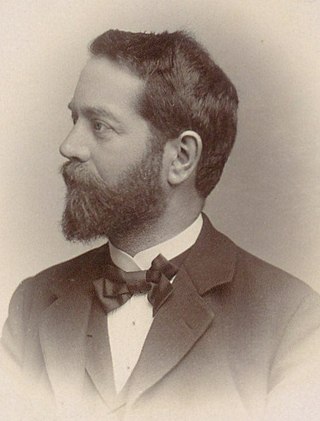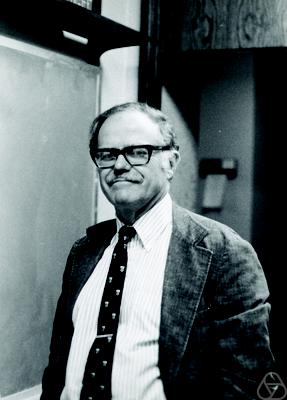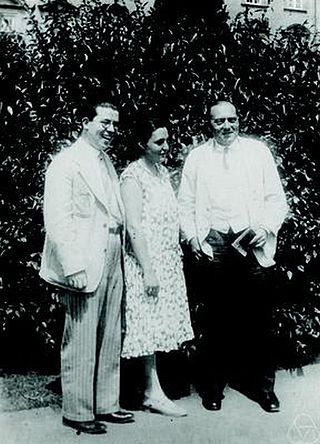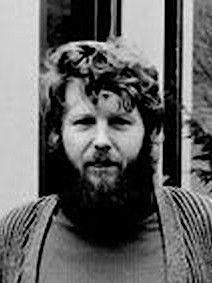Related Research Articles

David Hilbert was a German mathematician, one of the most influential mathematicians of the 19th and early 20th centuries. Hilbert discovered and developed a broad range of fundamental ideas in many areas, including invariant theory, the calculus of variations, commutative algebra, algebraic number theory, the foundations of geometry, spectral theory of operators and its application to integral equations, mathematical physics, and the foundations of mathematics.

Christian Felix Klein was a German mathematician and mathematics educator, known for his work with group theory, complex analysis, non-Euclidean geometry, and on the associations between geometry and group theory. His 1872 Erlangen program, classifying geometries by their basic symmetry groups, was an influential synthesis of much of the mathematics of the time.

Gerhard Karl Erich Gentzen was a German mathematician and logician. He made major contributions to the foundations of mathematics, proof theory, especially on natural deduction and sequent calculus. He died of starvation in a Soviet prison camp in Prague in 1945, having been interned as a German national after the Second World War.
In mathematics, local class field theory, introduced by Helmut Hasse, is the study of abelian extensions of local fields; here, "local field" means a field which is complete with respect to an absolute value or a discrete valuation with a finite residue field: hence every local field is isomorphic to the real numbers R, the complex numbers C, a finite extension of the p-adic numbersQp, or a finite extension of the field of formal Laurent series Fq( ) over a finite field Fq.
Hilbert's nineteenth problem is one of the 23 Hilbert problems, set out in a list compiled in 1900 by David Hilbert. It asks whether the solutions of regular problems in the calculus of variations are always analytic. Informally, and perhaps less directly, since Hilbert's concept of a "regular variational problem" identifies precisely a variational problem whose Euler–Lagrange equation is an elliptic partial differential equation with analytic coefficients, Hilbert's nineteenth problem, despite its seemingly technical statement, simply asks whether, in this class of partial differential equations, any solution function inherits the relatively simple and well understood structure from the solved equation. Hilbert's nineteenth problem was solved independently in the late 1950s by Ennio De Giorgi and John Forbes Nash, Jr.

Paul Isaac Bernays was a Swiss mathematician who made significant contributions to mathematical logic, axiomatic set theory, and the philosophy of mathematics. He was an assistant and close collaborator of David Hilbert.
In mathematics, Artin–Schreier theory is a branch of Galois theory, specifically a positive characteristic analogue of Kummer theory, for Galois extensions of degree equal to the characteristic p. Artin and Schreier (1927) introduced Artin–Schreier theory for extensions of prime degree p, and Witt (1936) generalized it to extensions of prime power degree pn.

Edwin Hewitt was an American mathematician known for his work in abstract harmonic analysis and for his discovery, in collaboration with Leonard Jimmie Savage, of the Hewitt–Savage zero–one law.

Kurt Schütte was a German mathematician who worked on proof theory and ordinal analysis. The Feferman–Schütte ordinal, which he showed to be the precise ordinal bound for predicativity, is named after him. He was the doctoral advisor of 16 students, including Wolfgang Bibel, Wolfgang Maaß, Wolfram Pohlers, and Martin Wirsing.

Claude Lemaréchal is a French applied mathematician, and former senior researcher at INRIA near Grenoble, France.
In mathematics, specifically group theory, isoclinism is an equivalence relation on groups which generalizes isomorphism. Isoclinism was introduced by Hall (1940) to help classify and understand p-groups, although it is applicable to all groups. Isoclinism also has consequences for the Schur multiplier and the associated aspects of character theory, as described in Suzuki and Conway et al.. The word "isoclinism" comes from the Greek ισοκλινης meaning equal slope.

Gottfried Maria Hugo Köthe was an Austrian mathematician working in abstract algebra and functional analysis.
Abhandlungen aus dem Mathematischen Seminar der Universität Hamburg is a peer-reviewed mathematics journal published by Springer Science+Business Media. It publishes articles on pure mathematics and is scientifically coordinated by the Mathematisches Seminar, an informal cooperation of mathematicians at the Universität Hamburg; its Managing Editors are Professors Vicente Córtes, Birgit Richter. The journal is indexed by Mathematical Reviews and Zentralblatt MATH.
Paul Georg Funk was an Austrian mathematician who introduced the Funk transform and who worked on the calculus of variations.
In the mathematical theory of Kleinian groups, a quasi-Fuchsian group is a Kleinian group whose limit set is contained in an invariant Jordan curve. If the limit set is equal to the Jordan curve the quasi-Fuchsian group is said to be of type one, and otherwise it is said to be of type two. Some authors use "quasi-Fuchsian group" to mean "quasi-Fuchsian group of type 1", in other words the limit set is the whole Jordan curve. This terminology is incompatible with the use of the terms "type 1" and "type 2" for Kleinian groups: all quasi-Fuchsian groups are Kleinian groups of type 2, as their limit sets are proper subsets of the Riemann sphere. The special case when the Jordan curve is a circle or line is called a Fuchsian group, named after Lazarus Fuchs by Henri Poincaré.
Mariano Giaquinta, is an Italian mathematician mainly known for his contributions to the fields of calculus of variations and regularity theory of partial differential equation. He is currently professor of Mathematics at the Scuola Normale Superiore di Pisa and he is the director of De Giorgi center at Pisa.
Moderne Algebra is a two-volume German textbook on graduate abstract algebra by Bartel Leendert van der Waerden, originally based on lectures given by Emil Artin in 1926 and by Emmy Noether (1929) from 1924 to 1928. The English translation of 1949–1950 had the title Modern algebra, though a later, extensively revised edition in 1970 had the title Algebra.
In mathematics, an explicit reciprocity law is a formula for the Hilbert symbol of a local field. The name "explicit reciprocity law" refers to the fact that the Hilbert symbols of local fields appear in Hilbert's reciprocity law for the power residue symbol. The definitions of the Hilbert symbol are usually rather roundabout and can be hard to use directly in explicit examples, and the explicit reciprocity laws give more explicit expressions for the Hilbert symbol that are sometimes easier to use.

Eberhard Freitag is a German mathematician, specializing in complex analysis and especially modular forms.
In functional analysis, a discipline within mathematics, a locally convex topological vector space (TVS) is said to be infrabarrelled if every bounded absorbing barrel is a neighborhood of the origin.
References
- Sieg, Wilfried; Ravaglia, Mark (2005), "Chapter 77. David Hilbert and Paul Bernays, Grundlagen der Mathematik" (PDF), in Grattan-Guinness, Ivor (ed.), Landmark writings in western mathematics 1640–1940, Elsevier B. V., Amsterdam, pp. 981–99, doi:10.1016/B978-044450871-3/50158-3, ISBN 978-0-444-50871-3, MR 2169816
- Hilbert, David; Bernays, Paul (1934), Grundlagen der Mathematik. I, Die Grundlehren der mathematischen Wissenschaften, vol. 40, Berlin, New York: Springer-Verlag, ISBN 978-3-540-04134-4, JFM 60.0017.02, MR 0237246, archived from the original on 2011-05-17
- Hilbert, David; Bernays, Paul (1939), Grundlagen der Mathematik. II, Die Grundlehren der mathematischen Wissenschaften, vol. 50, Berlin, New York: Springer-Verlag, ISBN 978-3-540-05110-7, JFM 65.0021.02, MR 0272596, archived from the original on 2011-05-17
- Hilbert, David; Bernays, Paul (1968) [1934], Grundlagen der Mathematik. I, Die Grundlehren der mathematischen Wissenschaften, vol. 40 (2nd ed.), Berlin, New York: Springer-Verlag, ISBN 978-3642868955, MR 0237246
- Hilbert, D.; Bernays, Paul (1970), Grundlagen der Mathematik. II, Die Grundlehren der mathematischen Wissenschaften, vol. 50 (2 ed.), Berlin-New York: Springer-Verlag, ISBN 978-3642868979, MR 0272596
- Hilbert, David; Bernays, Paul (2011) [1934/68], Grundlagen der Mathematik I — Foundations of Mathematics I, Part A: Prefaces and §§ 1–2 (in German and English) (1st ed.), London: College Publications, ISBN 978-1-84890-033-2, MR 3027390
- Hilbert, David; Bernays, Paul (2013) [1934/68], Grundlagen der Mathematik I — Foundations of Mathematics I, Part B: §§ 3–5 and Deleted Part I of the 1st Edn. (in German and English) (1st ed.), London: College Publications, ISBN 978-1-84890-075-2